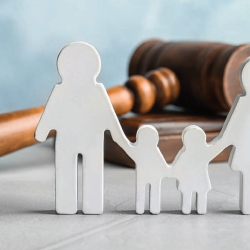Creating Self-Help Materials that Are Actually Helpful
 From the early days of this country’s existence, portions of the population have been unable to afford legal services. Today, that portion of individuals is so substantial that we accurately call this lack of representation a “crisis.” It is well documented that over 70% of civil and family law cases have at least one party that is self-represented, and over 90% of eviction and debt-collection cases in some jurisdictions involve an unrepresented defendant. The complexity of the system has only compounded the negative consequences of this crisis, but by understanding where people struggle, we can forge solutions to ease the difficulties of self-representation.
From the early days of this country’s existence, portions of the population have been unable to afford legal services. Today, that portion of individuals is so substantial that we accurately call this lack of representation a “crisis.” It is well documented that over 70% of civil and family law cases have at least one party that is self-represented, and over 90% of eviction and debt-collection cases in some jurisdictions involve an unrepresented defendant. The complexity of the system has only compounded the negative consequences of this crisis, but by understanding where people struggle, we can forge solutions to ease the difficulties of self-representation.
The data IAALS gathered from its Cases Without Counsel study, including in-depth conversations with self-represented litigants (SRLs), illuminates many areas where they fail to effectively handle their legal issues and court cases. At the most basic level, many SRLs have difficulty navigating the legal process, and relate it to taking a trip without a map. SRLs also emphasize that the forms they needed to fill out and submit were not only overwhelming in their quantity but were also very difficult to understand. If we want more people to get better justice outcomes, we need a better roadmap to guide them through the system when they don’t have a lawyer.
Efforts have been made to alleviate these issues by creating self-help materials that guide SRLs through their cases. These efforts align with the Cady Initiative Principles for Family Justice Reform, a partnership of IAALS, the National Center for State Courts, and the National Council of Juvenile and Family Court Judges. Principle 4 states that “courts should provide clear, straightforward information to parties about the court process. Courts should provide assistance to self-represented parties including procedural information and available resources to assist the family.” While efforts to create self-help materials are grounded in a desire to demystify complex processes, just how practically useful are these materials in aiding SRLs with their cases?
Using plain language instead of legalese is one of the most common self-help focuses. In essence, all the difficult-to-understand language that is littered throughout legal documents is rewritten to be clear and understandable to someone without a law degree. Doing this can be extremely helpful when implemented appropriately, but that does not always happen. Plain-language materials are often created by lawyers without direct input from the people who the materials are being created for.
The National Self-Represented Litigants Project (NSRLP) recently published an article on remarks by Dr. James Greiner, a law professor at Harvard Law School, who suggests that because plain language materials are drafted by legal insiders, they are not as useful as one might hope. This is because lawyers often fail to account for the stress, frustration, fear, and shame of self-representation—all of which exacerbates an SRL’s ability to digest and effectively apply self-help materials. It is also difficult for lawyers to stop thinking like lawyers, so when they develop these materials without outside input, the materials often still retain sophisticated language and unclear processes that are unusable to those without a law degree. One stark example of this is from a law professor who used to give his first-year law students self-help materials to test their usability. These students often struggled to use them, providing little hope for people with no formal training in the law.
It is important to point out that while some people like Dr. Greiner argue that self-help materials should be improved to better assist SRLs, there are others who argue self-help materials are a detriment to the legal profession. One argument is that people will always need a lawyer’s help to effectively handle their case, no matter how well self-help materials are developed. So, instead of wasting time developing these materials, the profession should focus on getting people connected with lawyers. A glaring oversight to this argument is that most people cannot afford a lawyer and do not qualify for legal aid. Aside from that, there are several legitimate reasons why some people prefer to not bring a lawyer into their legal issues (e.g., confidence in the ability to represent oneself in a simple, straightforward case or a desire to maintain a good relationship with the other party). We as a profession should not be actively forcing anyone to use lawyers’ services.
Another argument raised as to why self-help materials are harmful is the belief that these materials are what created self-representation: that people are only representing themselves nowadays because the profession has made it easy to do so. While some people may be proceeding pro se because they believe their case is simple enough, many people representing themselves in emotionally charged, high-stakes cases such as divorce or separation with children involved are wishing they could afford legal help. As one Cases Without Counsel participant expressed, “I was mostly nervous because I was afraid that if I did something wrong it might hinder my ability to see my children or to be a part of their lives.”
Self-help materials may not be able to replace the help that an experienced legal professional can provide, but for people who have no choice but to represent themselves, these materials—when created properly—can drastically change an SRLs experience and even their case’s outcome. The Cady Initiative Principles for Family Justice Reform state that “self-help materials that facilitate meaningful access help parties translate the information into action, to move their case forward, or achieve another goal within the court process.” So how can those within the legal profession create self-help materials that facilitate meaningful access? In 2019, IAALS partnered with law professor Lois Lupica to create Guidelines for Creating Effective Self-Help Information. This report provides 10 guidelines on how to increase the efficacy of existing self-help materials and assist in the development of new materials that empower people with information and an understanding of what to do with that information. The following are a few of those guidelines and how their implementation improves an SRL’s ability to comprehend and apply the information to their legal issues.
Guideline 1: Self-help materials should include line-drawn illustrations and visual depictions of concepts. Both have been shown to improve learning.
Research has shown that visual depictions of ideas and actions can improve learning. Visual imagery can ease anxiety, entertain so as to motivate, and facilitate an understanding of complex concepts. And the simpler the drawing, the better. Stick figure drawings and cartoons are superior to photographs or highly detailed drawings because learners generally lack the ability to distinguish important features in photographs or complex drawings from irrelevant details.
Guideline 2: Self-help materials must provide the seemingly mundane details of how the legal system works, including specific logistical information about how to interact with the formal legal system.
No detail is too mundane to include in self-help materials, from how to get to the courthouse, to what it will look like when they are waiting for a proceeding. From the perspective of the user, if self-help materials “designed” to be helpful fail on the small things, such as where to sit and what to expect next, why should the user trust them on the big things?
Guideline 6: Checklists and advanced organizers can provide the user with useful tools to keep organized and help them see the process as a whole.
Checklists can help the user understand the broad process and keep the user organized. Additionally, easy-to-read and easy-to-understand advance organizers provide context and relate each subsequent topic to what the user already knows. With the implementation of these tools, users demonstrate better learning outcomes and are less likely to be discouraged and walk away from a task.
Guideline 8: Self-help materials must be written at a fifth-grade reading level and in a conversational style.
As mentioned earlier, plain language is an important and common tool in self-help materials but is not always applied effectively. Self-help materials should be written the way people speak, so the language doesn’t necessarily have to be grammatical or follow language conventions. One effective tool that creators of self-help materials can use to determine their material’s reading level is the Flesch-Kincaid Reading Level Test. This free tool is an easy way to verify the simplicity of their language.
There is no question that there has been an increase in self-represented litigants over the past few decades. Opinions differ on what the cause is of this increase, but no matter the cause, the legal profession should feel an obligation to make the legal process as accessible as possible. Self-help materials are one way the profession is working to alleviate the burden of self-representation, but not all materials are created equally even if they are all created with the right motives.
With that understanding, as courts work to develop self-help materials or improve on existing ones, the 10 guidelines that IAALS developed should be the backbone of these efforts. They are grounded in research and are designed to provide the information necessary to help judges, lawyers, court administrators, and others to understand the problems facing our system and the people who depend on it—and to make improvements that will increase access, bolster public trust, and provide pathways for people to get the justice they seek.




